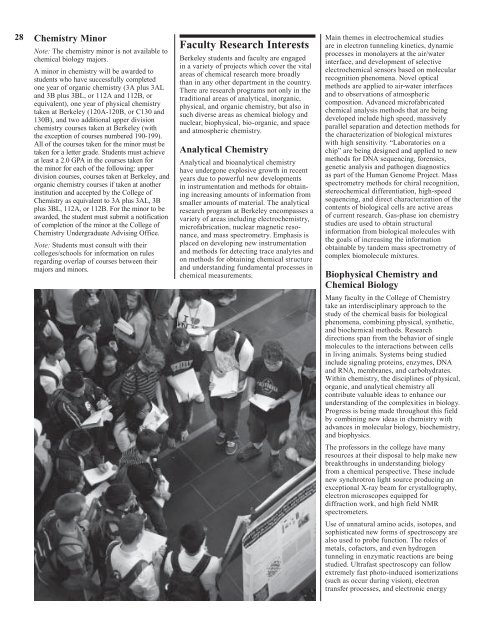12-13 Coc Guide v7 - College of Chemistry - University of ...
12-13 Coc Guide v7 - College of Chemistry - University of ...
12-13 Coc Guide v7 - College of Chemistry - University of ...
You also want an ePaper? Increase the reach of your titles
YUMPU automatically turns print PDFs into web optimized ePapers that Google loves.
28 <strong>Chemistry</strong> Minor<br />
Note: The chemistry minor is not available to<br />
chemical biology majors.<br />
A minor in chemistry will be awarded to<br />
students who have successfully completed<br />
one year <strong>of</strong> organic chemistry (3A plus 3AL<br />
and 3B plus 3BL, or 1<strong>12</strong>A and 1<strong>12</strong>B, or<br />
equivalent), one year <strong>of</strong> physical chemistry<br />
taken at Berkeley (<strong>12</strong>0A-<strong>12</strong>0B, or C<strong>13</strong>0 and<br />
<strong>13</strong>0B), and two additional upper division<br />
chemistry courses taken at Berkeley (with<br />
the exception <strong>of</strong> courses numbered 190-199).<br />
All <strong>of</strong> the courses taken for the minor must be<br />
taken for a letter grade. Students must achieve<br />
at least a 2.0 GPA in the courses taken for<br />
the minor for each <strong>of</strong> the following: upper<br />
division courses, courses taken at Berkeley, and<br />
organic chemistry courses if taken at another<br />
institution and accepted by the <strong>College</strong> <strong>of</strong><br />
<strong>Chemistry</strong> as equivalent to 3A plus 3AL, 3B<br />
plus 3BL, 1<strong>12</strong>A, or 1<strong>12</strong>B. For the minor to be<br />
awarded, the student must submit a notification<br />
<strong>of</strong> completion <strong>of</strong> the minor at the <strong>College</strong> <strong>of</strong><br />
<strong>Chemistry</strong> Undergraduate Advising Office.<br />
Note: Students must consult with their<br />
colleges/schools for information on rules<br />
regarding overlap <strong>of</strong> courses between their<br />
majors and minors.<br />
Faculty Research Interests<br />
Berkeley students and faculty are engaged<br />
in a variety <strong>of</strong> projects which cover the vital<br />
areas <strong>of</strong> chemical research more broadly<br />
than in any other department in the country.<br />
There are research programs not only in the<br />
traditional areas <strong>of</strong> analytical, inorganic,<br />
physical, and organic chemistry, but also in<br />
such diverse areas as chemical biology and<br />
nuclear, biophysical, bio-organic, and space<br />
and atmospheric chemistry.<br />
Analytical <strong>Chemistry</strong><br />
Analytical and bioanalytical chemistry<br />
have undergone explosive growth in recent<br />
years due to powerful new developments<br />
in instrumentation and methods for obtaining<br />
increasing amounts <strong>of</strong> information from<br />
smaller amounts <strong>of</strong> material. The analytical<br />
research program at Berkeley encompasses a<br />
variety <strong>of</strong> areas including electrochemistry,<br />
micr<strong>of</strong>abrication, nuclear magnetic resonance,<br />
and mass spectrometry. Emphasis is<br />
placed on developing new instrumentation<br />
and methods for detecting trace analytes and<br />
on methods for obtaining chemical structure<br />
and understanding fundamental processes in<br />
chemical measurements.<br />
Main themes in electrochemical studies<br />
are in electron tunneling kinetics, dynamic<br />
processes in monolayers at the air/water<br />
interface, and development <strong>of</strong> selective<br />
electrochemical sensors based on molecular<br />
recognition phenomena. Novel optical<br />
methods are applied to air-water interfaces<br />
and to observations <strong>of</strong> atmospheric<br />
composition. Advanced micr<strong>of</strong>abricated<br />
chemical analysis methods that are being<br />
developed include high speed, massively<br />
parallel separation and detection methods for<br />
the characterization <strong>of</strong> biological mixtures<br />
with high sensitivity. “Laboratories on a<br />
chip” are being designed and applied to new<br />
methods for DNA sequencing, forensics,<br />
genetic analysis and pathogen diagnostics<br />
as part <strong>of</strong> the Human Genome Project. Mass<br />
spectrometry methods for chiral recognition,<br />
stereochemical differentiation, high-speed<br />
sequencing, and direct characterization <strong>of</strong> the<br />
contents <strong>of</strong> biological cells are active areas<br />
<strong>of</strong> current research. Gas-phase ion chemistry<br />
studies are used to obtain structural<br />
information from biological molecules with<br />
the goals <strong>of</strong> increasing the information<br />
obtainable by tandem mass spectrometry <strong>of</strong><br />
complex biomolecule mixtures.<br />
Biophysical <strong>Chemistry</strong> and<br />
Chemical Biology<br />
Many faculty in the <strong>College</strong> <strong>of</strong> <strong>Chemistry</strong><br />
take an interdisciplinary approach to the<br />
study <strong>of</strong> the chemical basis for biological<br />
phenomena, combining physical, synthetic,<br />
and biochemical methods. Research<br />
directions span from the behavior <strong>of</strong> single<br />
molecules to the interactions between cells<br />
in living animals. Systems being studied<br />
include signaling proteins, enzymes, DNA<br />
and RNA, membranes, and carbohydrates.<br />
Within chemistry, the disciplines <strong>of</strong> physical,<br />
organic, and analytical chemistry all<br />
contribute valuable ideas to enhance our<br />
understanding <strong>of</strong> the complexities in biology.<br />
Progress is being made throughout this field<br />
by combining new ideas in chemistry with<br />
advances in molecular biology, biochemistry,<br />
and biophysics.<br />
The pr<strong>of</strong>essors in the college have many<br />
resources at their disposal to help make new<br />
breakthroughs in understanding biology<br />
from a chemical perspective. These include<br />
new synchrotron light source producing an<br />
exceptional X-ray beam for crystallography,<br />
electron microscopes equipped for<br />
diffraction work, and high field NMR<br />
spectrometers.<br />
Use <strong>of</strong> unnatural amino acids, isotopes, and<br />
sophisticated new forms <strong>of</strong> spectroscopy are<br />
also used to probe function. The roles <strong>of</strong><br />
metals, c<strong>of</strong>actors, and even hydrogen<br />
tunneling in enzymatic reactions are being<br />
studied. Ultrafast spectroscopy can follow<br />
extremely fast photo-induced isomerizations<br />
(such as occur during vision), electron<br />
transfer processes, and electronic energy




